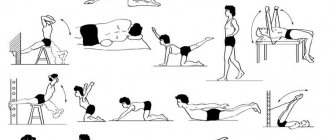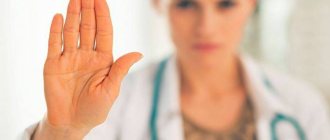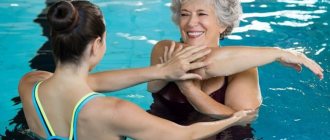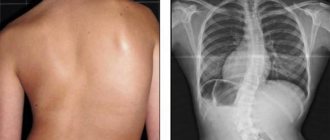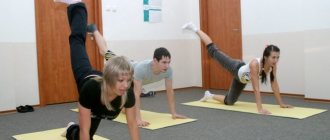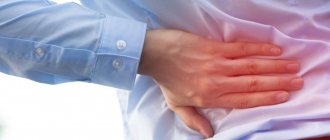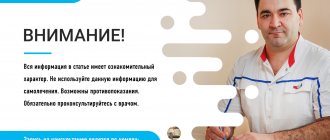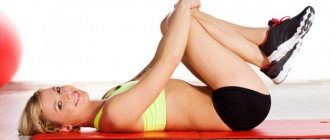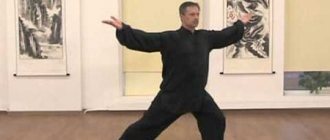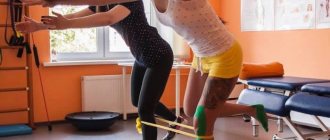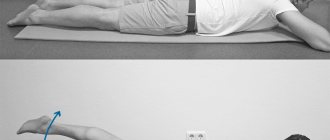A set of basic exercises
A basic gymnastics complex for grade 2 scoliosis, designed to strengthen the muscular skeleton, ligaments and eliminate postural defects.
Before using a set of exercises, in addition to consulting a specialist and assigning individual indications when using exercises, you should familiarize yourself with the basic rules and requirements:
- Exercises to get rid of grade 2 scoliosis do not use stretching or twisting.
- Avoid hanging on the horizontal bar. Pull out only with the help of additional equipment and support.
- If you experience the slightest discomfort, you should stop using gymnastics and go to a doctor for diagnosis.
- Exercises are repeated 5-15 times depending on preparation.
Experts recommend doing exercises for scoliosis at home regularly to achieve a better corrective effect.
As with the beginning of any physical activity, in therapeutic exercises for scoliosis, a warm-up part is used to prepare muscles, ligaments and joints for stress.
- We carefully watch our back, keep it straight. We perform the step on the spot.
- We rise on our toes and simultaneously raise our clasped hands up. We reach up. We descend smoothly.
- We fix our feet on the floor (as if glued), continue to stretch upward.
- Feet shoulder width apart. Hands on shoulders. We make circular movements back and forth with our elbows.
- Now in the same position, bring and spread your elbows, straining your shoulder blades.
- We lie down on the floor with our backs. Legs are bent, arms are bent. We reach towards each other with the elbow and the opposite knee.
- We continue lying down, pulling one knee towards us with our hands, then the other. We make stops to fix the stretch.
- Lying down, holding the floor with your hands to fix the position. We raise our legs together and move left and right, helping with our hands.
- We don’t stand up, we pull our knees together to our chest, at the same time we clap our hands behind our knees or simply touch them with our palms.
The following sequence must be performed every day; this is a classic complex for the treatment of scoliosis. Exercises “bicycle”, “swallow”, “scissors” are repeated several times throughout the complex.
Exercise that shapes posture. We lean on a wall or a fixed door. We go down the wall with our backs, as if we were sitting down, to the maximum feasible level, but no more than a right angle at the knees.
- We lie down on our stomachs. Hands over the body. We raise only the shoulder girdle, the face looks forward.
- Hands clasped behind head. We also raise our shoulders.
- We rest our palms on the floor and raise our shoulder girdle again. Let's stretch.
- Now I don’t change the position, we lift up one by one, then the other leg.
- Arms outstretched in front of you. We simultaneously raise our arms and legs, stretching upward. Your body should resemble a boat.
- We get into a position on all fours. Further, all exercises of the complex will begin from this position. We stretch our left hand slightly upward and our right leg back. Then we change position.
"Scared cat" exercise. Bend your lower back upward. Then the camel pose, the lower back bends down. At the same time, the abdominal muscles are always tense, breathing is even.
We sit on our heels. We begin to bend forward, trying to touch the floor with our forehead. At the final stage, relaxation exercises are performed. We take turns walking on our heels and then on our toes. Complete 50 steps. We stand straight. Hands up, elbows bent at 90 degrees. We bring the shoulder blades together as much as possible. We take deep breaths and exhales, making circular movements with our hands through the sides.
Slowly, smoothly and paying attention to your breathing.
On the stomach
Further, exercises for the prevention of scoliosis are given that can also be used to correct the back in case of the disease in stages 1 and 2.
- Lie on your stomach with a pillow under your thigh. Stretch your arms forward so that they are in line with the body. Then slowly, as I raise my arm up, I try to lift my entire upper body off the floor, bending up and back. The movement should be very slow and smooth and not cause the slightest discomfort under any circumstances.
- Do the same thing, but in this case you can remove the pillow from under your hips. Don’t stretch your arms forward, but, on the contrary, lower them along your body and try to lift them up behind your back. If your physical fitness allows, then you can try to simultaneously raise your upper body and lift your legs, lifting them off the floor. It is worth remembering that training for grade 1 scoliosis allows for exercises with maximum amplitude. Whereas in more serious stages of development of the disease, movements must be made more smoothly and bending down to shallower depths. Always ensure that the movements performed do not cause discomfort.
In order to strengthen the back muscles, you can treat grade 1 scoliosis at home or perform certain movements in the gym.
Prohibited sports
It is possible and necessary to engage in physical exercise and sports even if your posture is poor.
You just need to follow certain rules and be more careful about the load on your back. In many cases, consultation with a doctor is mandatory.
Running with scoliosis
As for running, it does not fall into the prohibited exercises. The only exception is the form of the disease of 3 and 4 degrees.
There are a number of features of this type of sport:
- running should be moderate, your back should not get tired from it; the appearance of aching pain is a clear signal to end the exercise;
- It is better to coordinate the duration of the lesson with the doctor;
- It is not advisable to run on asphalt - it is better on special sports tracks or dirt, earthen surfaces.
Therefore, the question of whether it is possible to run with poor posture will often receive a positive answer (except for grades 3 and 4).
IMPORTANT - If running is not possible, an excellent alternative would be sports, walking or Nordic walking - a fashionable trend in modern physical education.
Therefore, the answer to the question of what is not allowed with scoliosis will be a whole list, which will include most sports:
boxing and weightlifting; tennis (table tennis can also be played with scoliosis of the 2nd degree); football, hockey; volleyball basketball; equestrian sport (it can be practiced with caution only in the case of 1st degree of development of the pathology); professional cycling
NOTE
Recreational cycling is permitted if the abdominal muscles are sufficiently developed. Otherwise, constant skating will lead to additional sagging of the abdomen, which will increase the load on the back. In this case, the answer to the question of whether it is possible to engage in cycling with scoliosis will be negative.
Doing rhythmic gymnastics or sports if you have poor posture is very dangerous. The reason is that the movements are often abrupt and asymmetrical - the bones of the spine are subjected to strong impact, which can increase their mobility and lead to even greater curvature.
- Swimming is the most effective means of treating scoliosis: the gentle load in the water, the ability to use all muscle groups and joints at once, and relax the spine provide a beneficial effect of this type of activity not only on the back, but also on the body as a whole. Usually the doctor develops a special program of therapeutic swimming and therapeutic water aerobics.
- Practicing artistic and ballroom dancing will have a great effect not only on the beauty of the figure, but will also give the spine the necessary plasticity and flexibility, so this type of activity is allowed. The exception is some active types of modern street dances, which involve somersaults, sharp turns, etc.
- Ice skating is also a permitted activity, and it helps strengthen the back muscles, thereby reducing the load on the spinal column. The exception is speed skating. figure skating, where there is a high risk of falls and injuries.
- Recreational skiing also has a good effect on the back muscles and strengthens them - thanks to this, it is possible not only to prevent poor posture, but also to successfully cure the disease at an early stage (grade 1).
- Physical therapy exercises, designed specifically for the treatment or prevention of poor posture, serve as one of the main means of combating the disease. They are developed by the attending physician.
We advise you to study: Is it possible to ride a bicycle with a herniated disc?
Contraindications for scoliosis are very different, therefore, in order to find out what can be done in case of poor posture, what to do in case of a disease of varying degrees (including to cure it), and what exercises cannot be done in case of scoliosis, you should discuss the situation in detail with your doctor .
And a little about secrets
Have you ever experienced constant back pain, neck pain or unbearable joint pain? Judging by the fact that you are reading this article, you or your loved ones are already familiar with them personally. And of course you know firsthand what it is:
- Constant aching and sharp pain;
- Inability to move comfortably and easily;
- Constant tension in the muscles of the back and neck;
- Unpleasant crunching and clicking in the joints;
- Sharp shooting in the spine or causeless pain in the joints;
- Inability to sit in one position for a long time.
To study Correction of posture in adults
Now answer the question: are you satisfied with this? Can such pain be tolerated? How much money have you already spent on ineffective treatment? That's right - it's time to end this! Do you agree? That is why we decided to publish an interview with professor, Dikul Valentin Ivanovich, in which he revealed the secrets of getting rid of pain in the back, neck and joints. Read more... »
REMEMBER! Sore joints can be treated simply!
Any doctor will offer you a number of methods for treating joints, from trivial and ineffective to radical: you can regularly undergo a course of therapy with pills, returning every six months; you can trust folk remedies and believe in miracles... But perhaps it is more correct to treat not the effect, but the cause? Read the article and find out how to quickly get rid of joint pain in just a couple of weeks!
MORE >>>
What do doctors say about treating joints and spine?
Dikul V.I., Doctor of Medical Sciences, Professor: I have been working as an orthopedist for many years. During this time I had to deal with various diseases of the back and joints. I recommended only the best drugs to my patients, but still the result of one of them amazed me! It is absolutely safe, easy to use, and most importantly, it acts on the cause. As a result of regular use of the product, the pain goes away within a day, and within 21 days the disease completely recedes 100%. It can definitely be called the BEST remedy of the 21st century...
Read more >>
IT IS IMPORTANT TO KNOW! Orthopedist: “Penny product No. 1 for restoring normal blood supply to joints. Your back and joints will be the same as when you were 18 years old, just apply it once a day..
OUR READERS RECOMMEND!
For the treatment and prevention of ARTHROSIS, ARTHRITIS and other diseases of the joints and back, our readers use the increasingly popular method of rapid and non-surgical treatment, recommended by leading orthopedists. After carefully reviewing it, we decided to offer it to your attention. Read more >>
(function(w, d, n, s, t) { w = w || []; w.push(function() { Ya.Context.AdvManager.render({ blockId: 'RA-424216-18', renderTo : 'yandex_rtb_R-A-424216-18', async: true }); }); t = d.getElementsByTagName('script'); s = d.createElement('script'); s.type = 'text/javascript '; s.src = '//an.yandex.ru/system/context.js'; s.async = true; t.parentNode.insertBefore(s, t); })(this, this.document, 'yandexContextAsyncCallbacks '); (function(w, d, n, s, t) { w = w || []; w.push(function() { Ya.Context.AdvManager.render({ blockId: 'RA-424216-14', renderTo : 'yandex_rtb_R-A-424216-14', async: true }); }); t = d.getElementsByTagName('script'); s = d.createElement('script'); s.type = 'text/javascript '; s.src = '//an.yandex.ru/system/context.js'; s.async = true; t.parentNode.insertBefore(s, t); })(this, this.document, 'yandexContextAsyncCallbacks '); (function(b,c){c.id=b.querySelector('div');var a=b.createElement('script');a.src='//tt.ttarget.ru/s/tt3. js?v=2′;a.async=!0;a.onload=a.readystatechange=function(){a.readyState&&'loaded'!=a.readyState&&'complete'!=a.readyState||(a. onload=a.readystatechange=NULL,TT.createBlock(c))};b.getElementsByTagName('head').appendChild(a)})(document,{block: 4539, count: 0});
Is it possible to cure scoliosis with manual therapy?
Manual therapy is a certain set of manual manipulations carried out for health-improving activities of the bone structure. In ordinary language, manual therapy is treatment with your hands. Treatment is carried out in three stages:
- Relaxation of all muscles of the spinal girdle.
- Muscle stretching.
- Restoring bone mobility.
Manual therapy is divided into two methods of influence: soft and hard. The soft technique consists of a relaxing effect followed by stretching; this method allows you to work 1-2 vertebrae in one session. This allows us to conclude that this technique is systematic. The hard method involves relaxation followed by sharp pressure to direct the joints into the correct position.
It should also be remembered that, as with any treatment, there are contraindications. If the person being treated has at least one of the diseases listed below, then it is worth finding another way to treat scoliosis.
- Presence of infectious diseases of the spine.
- Tumors.
- Spinal cord compression.
- Osteoporosis.
- Oncological diseases.
- Early postoperative period.
Also, manual therapy is contraindicated in very young patients. In any case, before coming to the massage room, a consultation with a therapist is required.
Who is a chiropractor? First of all, a certified specialist in the field of orthopedics and neuropathology, and only then – a specialist in manual healing. Treatment with a chiropractor begins with an examination, clarification of all complaints and additional examination in the form of x-rays (if necessary).
Manual therapy, unfortunately, does not completely solve the patient’s problem. The spine can be fully straightened only at a young age. But it is quite possible to restore it and remove pain.
https://youtube.com/watch?v=Anvvev7zRpY
It is also important to remember that manual therapy is effective in combination with physical therapy prescribed by a doctor afterward. It is necessary to perform exercises after each therapy session to consolidate the results. And another thing is that it is impossible to achieve complete recovery in one session; on average, 10 sessions are prescribed, although you can feel relief and a difference after the first session.
Every six months it is necessary, for preventive purposes, to take a course of several sessions.
And another thing is that it is impossible to achieve complete recovery in one session; on average, 10 sessions are prescribed, although you can feel relief and a difference after the first session. Every six months it is necessary, for preventive purposes, to take a course of several sessions.
How to treat scoliosis
Is it possible for a child to be completely cured of scoliosis? Will swimming help?
Scoliosis is a pathology of the musculoskeletal system, in which there is a lateral skew of the spine with rotation of the vertebrae around their axis. Over time, this leads to disruption of the functioning of not only the chest, but also the organs located inside it.
The true causes of the development of this disease are not known for certain, but there are a number of risk factors that can contribute to the appearance of this pathology, these include:
- congenital vertebral deformity;
- flat feet or different leg lengths;
- pathological conditions of the neuromuscular system;
- weak back muscles;
- metabolic disorders in cartilage and bones;
- rapid growth of the child;
- incorrect posture, improper distribution of the burden;
- hereditary predisposition.
Quite often, this disease develops rapidly, so it is very important not to miss the moment and start treatment. As for the treatment of scoliosis in a child, it should be started immediately, immediately after detection
It is possible to straighten the spinal column while the child is still growing.
In the presence of the first degree of scoliosis, the main role in the treatment plan is strengthening the muscle corset; massage (but not manual therapy), therapeutic exercises and physiotherapeutic procedures will help with this. The treatment program should be developed strictly individually and will depend on the severity of changes in the spinal column, the age of the child and his condition
It is important to remember that the treatment program for one small patient will be completely ineffective for another.
For scoliosis with a curvature greater than 10 degrees, spinal fixation using a corset is added to the muscle strengthening program. In more severe cases, surgical intervention is resorted to.
Parents of a child with scoliosis must provide their child with:
- living conditions: orthopedic mattress, properly equipped place to study, a backpack instead of a briefcase;
- regular physical exercise to train and strengthen the back muscles of the internal organs.
Treatment of spinal curvature is a complex task that requires, on the one hand, highly qualified orthopedist, and on the other hand, the active participation and understanding of mother, father and child.
Children's
Gymnastics for kyphosis in children requires even more training with a specialist. In children, the back is more flexible, therefore, it is easier to correct the pathology, but it can also cause harm with incorrectly selected or performed exercises.
Let's consider an approximate set of physical therapy classes for children:
- Rotation of the pelvis around its axis.
- We hold the stick above our head and alternately bend forward, backward, left and right.
- We sit down on the floor, hold the stick in front of us with outstretched arms, and lean forward.
It is also useful to perform standard bends, head rotations, etc. But remember that kyphosis requires an individual selection of exercises; it is better to involve a professional for this.
In childhood, complete recovery from kyphosis is not excluded, since the vertebrae in children are soft and flexible. In the early stages, the following are effective: physical therapy complex, physiotherapy, massage.
Features of children's gymnastics:
- exercises should be performed under the supervision of parents or a specialist;
- discomfort or pain is a reason to stop exercising and consult a specialist;
- Control of load distribution is important.
A set of exercises for children involves lifting the body from feet to toes. Flexion of the upper and lower limbs in the starting position lying on the back. A simultaneous raising of the arms and legs while lying on the stomach or a simultaneous lifting of the body and lower extremities with a gymnastic stick, which is placed between the back and arms, is shown.
Exercises with a gymnastic stick improve metabolic processes and respiratory function. For children, it is considered an effective therapeutic method that allows increasing blood circulation around the spinal column, joints, and relieving congestion.
The main goal of physical exercises for kyphotic deformity is to strengthen the muscle corset and develop the manner of holding yourself correctly. Classes are conducted as prescribed by a doctor, strictly according to the established scheme. The patient must control his posture and correlate the position of his shoulders with the center of gravity.
If you find an error, please highlight a piece of text and press Ctrl Enter. We will definitely correct it, and you will suffer karma.
Exercises in the gym
Paradoxically, in stages 1 and 2 of the disease, exercise in the gym is not prohibited. Moreover, with proper development of the complex and execution technique, they have a positive effect on the body. Exercises strengthen the muscle corset, open the smallest capillaries, and as a result, blood supply to the tissues improves.
Features of fitness classes
Did you know that...
Next fact
When doing fitness, it should be taken into account that some exercises place a strong load on the spinal column and can be traumatic. For these reasons, jumping and sharp turns should be avoided. Classes with elements of yoga and Pilates are optimal.
Basic rules when doing fitness:
- Exercises shouldn't hurt.
- Pilates promotes overall recovery, so exercise should be fun and not make you feel bad.
- You can't overexert yourself. After class you should feel pleasantly slightly tired.
The following exercises can be performed in the fitness room:
- Plank.
- Hanging leg raises.
- Pull-ups.
- Push ups.
- Lifting the pelvis while lying on your back.
- Abdominal exercises.
- Brisk walking on a treadmill (not running).
- Exercise on an exercise bike (with a supporting backrest).
An exercise bike has a positive effect on the cardiovascular system, strengthens the muscles of the thighs and buttocks. At the same time, the muscles of the lower back are strengthened, and the load on the spine is minimal.
Features of the disease and classification
Kyphosis is a curvature of the spine in the anteroposterior direction with a convexity posteriorly. Due to the deformation, a round back with sagging shoulders is formed. The shoulder blades take on a wing-like shape, the upper body leans forward, and the stomach protrudes slightly.
Mobility of the chest and ribs worsens. Because of this, the vital capacity of the lungs becomes smaller, respiratory function and cardiac activity are impaired. Kyphosis negatively affects the bones of the skeleton, muscles, ligaments; it is dangerous because it leads to disease of the entire body.
The changes that occur reduce the functional ability of the spine, worsen posture, and disrupt statics, dynamics, and circulatory function.
There are different types of disease. There are congenital and genotypic, or hereditary kyphosis. The first is provoked by a defect in the development of the anterior parts of the vertebrae. Genotypic kyphosis is repeated in several generations, the type of inheritance is dominant. Acquired kyphosis is also diagnosed.
Classification:
- compression kyphosis – a disease caused by a compression fracture of the vertebral bodies;
- infantile, or rachitic kyphosis - a pathology that develops as a result of rickets, has the appearance of an arc at the level of L1-L3;
- kyphosis associated with ankylosing spondylitis, or ankylosing spondylitis;
- senile kyphosis is a disease that occurs as a result of age-related degenerative changes in the intervertebral discs, weakness of the muscular system of the spinal column;
- presenile kyphosis – formed in women after the completion of the menstrual cycle due to hormonal disorders and decreased bone density;
- tuberculous kyphosis - pathology is caused by the destruction of the vertebral bodies, their compression during tuberculous spondylitis.
Acquired kyphosis can accompany systemic diseases and appear after surgical operations.
Causes
Modern life is characterized by the desire to increase daily comfort. But this leaves its mark on the musculoskeletal system, including the spine. Inactivity, incorrect posture, and asymmetrical physical activity contribute to the appearance of pathological lateral curvature - scoliosis.
Other factors are also important in the development of the disease:
- Weakness of the muscular corset.
- Neurological problems.
- Connective tissue dysplasia.
- Traumatic injuries.
- Consequences of operations.
- Postponed rickets.
But in most cases, unfortunately, it is not possible to establish the cause of scoliotic deformation - then they talk about the idiopathic nature of the pathology.
Sports for scoliosis
There is an opinion that sports activities with scoliosis are contraindicated, and in support of this idea, certificates are provided about exemption from physical education at school. However, liberation is given not because children with scoliosis are prohibited from any physical activity, but because in physical education lessons the approach to children is the same: jump - everyone does it, tumble - like that together.
We advise you to study - Yoga for the back and spine: home complex
And schoolchildren suffering from scoliosis should neither jump (especially high), nor tumble, nor engage in exercises that load one side of the body. After all, sudden movements of the spine and asymmetrical loads aggravate the course of the disease. At the same time, complete treatment of scoliosis in children is impossible without sports activities. These primarily include physical therapy, but some ordinary sports also benefit such children.
Swim, swim and swim some more
The best sport is swimming, especially with a long gliding phase - moving with a foam board, using fins, long diving, performing asterisk exercises. The swimming style is only breaststroke (back and stomach). Children with scoliosis should not flounder like a dog - this increases the stoop, and they should not swim crawl or butterfly - these styles increase the mobility of the spine, which interferes with the stabilization of scoliotic deformity.
Swimming is included not only in the fight against scoliosis, but also in the treatment of PEP. dislocation of the hip joint and other pathologies. After all, this is an activity:
- helps the spine to unload,
- strengthens the muscle corset, and symmetrically,
- develops coordination of movements,
- allows you to create conditions for the normal development of vertebrae and joints,
- harmonizes the nervous system.
If there is no pool nearby
If it is not possible to visit the pool, you should organize other physical activity for your child. This could be skiing (without poles or with simultaneous pushing with two poles), leisurely skating - regular and roller skating, volleyball with two-handed passing. Running on a soft surface is also recommended - sand often plays its role.
How long should you practice
How long it is necessary to do exercises and gymnastics to correct scoliosis depends on the stage of the disease, as well as the age of the patient. Exercise therapy only brings results with long-term sessions. When scoliosis is diagnosed in a child, it is very important to strictly follow the doctor’s recommendations, since the skeleton continues to form at an early age. In some cases, you have to make a set of therapeutic exercises for scoliosis part of your life - this is the only way to prevent the condition from worsening.
What sports should you do if you have scoliosis?
At the same time, it should be borne in mind that a sedentary lifestyle is also harmful for diseases of the musculoskeletal system, and some sports, on the contrary, can help correct a curved spine. Sports that are “useful” for scoliosis include skiing and skating, in cases where high speed of movement is not required. In addition, situations that pose a high risk of falling and injury should be avoided. By the way, many doctors believe that hockey is not dangerous if you avoid situations of extreme excitement (that is, you need to play not for the sake of winning, but for the sake of the game itself).
Today, many doctors advise replacing your favorite jogging with regular walking, which brings much more benefits and at the same time spares the spine and joints. If we talk about sports, then race walking and such a new sport as walking with Nordic poles are very useful for scoliosis.
Breaststroke swimming is very useful, especially on the back. Moreover, swimming can help correct a crooked spine. However, this requires the help of a specialist who would select a set of exercises in water, taking into account all parameters of the pathology (type of scoliosis (right-sided, left-sided or s-shaped scoliosis), localization of the curvature (thoracic, lumbar, cervicothoracic scoliosis, etc.) , degree of curvature).
It must be said that physical therapy is included in the treatment of scoliosis in both children and adults. A properly selected program of corrective exercises can significantly reduce the degree of curvature, and in some cases, completely get rid of scoliosis. The likelihood of healing increases in cases where physical therapy is combined with other treatment methods (back massage, osteopathic treatment, acupuncture, etc.).
Many patients, having crossed the 25-year mark, refuse treatment for scoliosis, especially in cases where it is a minor pathology (grade 1 or 2). Meanwhile, treatment by a professional doctor helps to significantly reduce the severity of the defect and prevent the development of early osteochondrosis and other complications of scoliosis in adults.
Be healthy!
Severity
This is another important factor by which scoliosis is assessed. Treatment in adults, or rather, its effectiveness and duration, depend on the stage at which you seek help from a doctor. When might a person notice that he needs help? This is usually visible to the naked eye. If you ask one of your relatives to look at the silhouette of your back from behind, even a slight asymmetry of the shoulders and shoulder blades will be noticeable.
- 1 - the curvature still has a small angle, about 5 degrees. But already at this stage it becomes noticeable that the shoulder is raised. There is a stoop, the head is lowered, and there is a clear asymmetry at the waist.
- 2 – the angle of curvature is up to 30 degrees. The asymmetry of the waist and neck is very visible.
- 3 – deformation of the figure. The rotation of the vertebrae reaches 30 – 60 degrees. Sagging of the abdominal muscles occurs.
- 4 - the angle of curvature is more than 60 degrees. Usually people say that they cannot sleep lying down, feeling comfortable only in a sitting position. The ribs sink and a hump appears.
What sports are good for scoliosis?
Only in the initial stages does scoliosis present as a curvature of the spine and purely external deformities. Gradually developing, the pathology begins to manifest itself as pain and discomfort, worsening motor function. Therefore, one of the main therapeutic tasks is to prevent the development of degenerative processes, which sports will help with.
Sports prohibited for scoliosis
However, the harmonious development of healthy posture can only be achieved by engaging in the right sports, while some games and seemingly useful exercises only contribute to the worsening of spinal deformities. In particular, these are:
- fencing, boxing and tennis #8212; involve the application of force to only one part of the body, accordingly, there is an uneven distribution of loads, which does not give a positive therapeutic result;
- weightlifting, wrestling or high jumping - with sufficient “symmetry”, such sports are associated with increased loads on the spine, and can provoke protrusion along with scoliosis, which is fraught with serious complications;
- sports gymnastics - since the spinal column of a patient with scoliosis has increased flexibility and a tendency to deformation, these exercises only contribute to curvature;
- football, hockey and basketball are dangerous due to forceful consequences, in particular, injury to the spine during jolts;
- Cycling is allowed, but only on a bicycle with a high handlebar, otherwise a “round” back may form, which leads to kyphosis.
These sports create asymmetry of loads, the compensation of which also occurs asymmetrically, and in the direction of the development of deformation. If the first three categories of sports loads are prohibited even with stage I scoliosis, then the last two belong to the group of mixed sports, and they can be practiced by patients with degrees I and II, subject to certain restrictions.
Running helps strengthen all muscle groups, so it is contraindicated only at an advanced stage of the disease. However, it is better for children to prefer swimming and pull-ups on the horizontal bar, or at least hanging, to running.
The main benefits of swimming
Exercises in the pool have a whole range of positive effects, beneficially affecting all functional systems of the body. Frequent water procedures promote holistic health, and improvements are observed even in patients with pathologies associated with scoliosis.
It is advisable to learn to combine swimming and breathing techniques, since proper oxygen exchange with symmetrical loads is the best sports remedy for scoliosis. To do this, you should consult with a coach and learn several swimming techniques.
Swimming on the back is considered the most useful, although in the absence of progressive scoliosis, you can use some elements from the “butterfly” or “crawl”. Assessing the impact of these procedures as a whole, the following advantages can be identified:
- strengthening the muscle corset;
- recreating normal conditions for the development of vertebrae;
- development of movement coordination;
- complete muscle relaxation and unloading of the spine.
Doctors advise that when swimming, you spend more time not on strength loads to train your arms, but on gliding on the water, during which maximum stretching of the spine occurs without external influences. In this case, water turns out to be the best bone-setter. Also, during the session, you need to do three sets of pull-ups on parallel bars installed near the sides. First, the water will be pushed out, and this exercise is easy to do even by people with weak muscles. And secondly, in an unloaded state, the spine will straighten better and easier, because there are no compensatory forces. Even when entering the pool for the first time, a person will be able to do up to 30 pull-ups in 3 approaches. And such treatment is not difficult, and interesting, and effective.
We advise you to study – Corset for scoliosis
Symptoms
Right-sided scoliosis has its own manifestations, which depend on the severity of the curvature. The initial stages of the development of pathology often go unnoticed, since many people mistake it for a normal stoop. Even at the second stage there are no subjective complaints, but changes are visually noticeable: different levels of the shoulders and shoulder blades, asymmetry of the waist triangles. In this case, a secondary arch may form at the level of the lumbar region. The third degree of scoliosis is characterized by more significant impairments:
- Deformation of the back and chest.
- The lower ribs may touch the iliac crests.
- Disorders of the function of internal organs: shortness of breath, increased heart rate.
Right-sided thoracic scoliosis of the 4th degree is accompanied by a severe curvature of the spine, which leads to persistent back pain and pulmonary heart failure. There may be weakness in the lower extremities, as well as spinal disorders, which cause disability.
Basic rules for doing exercise therapy for scoliosis
In order not to cause further harm to the child’s health, you need to ensure that the following recommendations are followed:
- Children under 7 years of age must train in the presence of adults.
- If discomfort or pain occurs, the activity should be stopped.
- You need to practice on a hard surface - on the floor, placing a special mat or towel.
- All exercises are done slowly, the required number of times.
- The technique of execution is as close as possible to that described.
And lastly, do not start physical therapy and gymnastics classes for scoliosis unless prescribed by a doctor.
Physical therapy is a great way to correct a crooked spine and strengthen your back muscles. Even small children enjoy doing the exercises. Classes can be conducted anywhere - at home, outdoors, in a clinic under the supervision of a doctor. Exercise therapy has virtually no contraindications; it is a free and most importantly effective way to improve the posture of a child or teenager.
Hippotherapy, an alternative treatment for children with scoliosis
Children diagnosed with scoliosis are usually exempted from physical education lessons in schools.
Nowhere in schools do they have special programs for them. Instead of properly loading the muscle corset with properly selected physical exercises and recommending available sports, they are forced to plunge into the abyss of physical inactivity.
This state of affairs causes serious concern for doctors working in the field of sports medicine, orthopedists, and physical therapy specialists. Recently, they have come to a consensus that equestrian sport can boast excellent restorative and health-improving results in the rehabilitation of children with scoliosis. And they strongly recommend it to all children suffering from scoliosis in any form.
It turns out that horse riding significantly improves the condition of children with systemic scoliosis and dysplastic scoliosis of 1-2 degrees. Communication with animals during training makes them especially attractive and useful for children and adults. Why did experts rate horse riding lessons so highly?
- Proper rider seating requires perfect posture. It is recommended to keep your back straight throughout the entire workout. And children fulfill this requirement. Thus, 1-1.5 hours a day, keeping your back in the correct position without a corset, using your own muscles - this is the best training for the muscle corset, without violence against yourself. Children do this with pleasure.
- When riding a horse, there is a constant massage of the intervertebral discs, soft but constant, for quite a long time. This gives an excellent therapeutic effect.
- Children suffering from dysplastic scoliosis tolerate training well in equestrian sports. The difference in leg length during training does not in any way affect the achievement of excellent results in mastering horse riding. Thus, the child does not feel inferior, and this improves his psychological state.
- Horseback riding is recommended not only for children, but also for adults suffering from scoliosis. The therapeutic effect will exceed all your wildest expectations.
What sports are contraindicated for scoliosis?
- Jogging is not recommended. Too strong a shock wave when landing on the foot while running contributes to even greater deformation of the spinal column, causing pain. It is better to replace running with sports or Nordic walking;
- Weightlifting sports are contraindicated. You can't lift weights. Any axial load on the spinal column should be avoided. This point should be taken into account by everyone involved in bodybuilding. You should not perform exercises that place stress on the long back muscles, deadlifts, or Roman chair sit-ups.
If you intend to play sports with a diagnosis of scoliosis, you should definitely undergo an examination and get competent advice from a physiotherapist. The latter will tell you which sport will be most optimal for you.
Prohibited exercises for SCOLIOSIS
Scoliosis is a fairly common disease around the world. Every person should monitor their posture and avoid physical overload of the body in order to avoid curvature of the spine.
Scoliosis, a common spinal disorder, places strict restrictions on certain activities. Let us consider in more detail the characteristic features of the disease and therapeutic measures.
Scoliosis: features of the disease and types of limitations
- What is scoliosis: features of the disease
- Types of restrictions
- Prohibited sports
- What are the dangers of physical overload?
What is scoliosis: features of the disease
Scoliosis is the curvature of the spine relative to its axis; it can be either acquired or congenital.
Important! If scoliosis is aggravated by stooping, the disease is called kyphoscoliosis. It greatly affects a person's posture.
The most common are lesions of the thoracic and lumbar regions. This leads to the fact that the human body is visually shifted to the left or right, which is even more noticeable when bending forward. This curvature is called C-shaped.
If the part of the spine located in the thoracic region is displaced to one side, and that located in the lumbar region - to the other, such a curvature is called S-shaped. If there are 3 curvatures in the spine, this asymmetry is called Z-shaped.
General contraindications for illness
With such a serious spinal disease, a number of contraindications must be taken into account.
Thus, it is prohibited to perform the following actions:
- remain in the same position for half an hour or more. You should periodically change your body position and do a warm-up, as well as do exercises every hour to relax your back muscles;
- carry a heavy load only in the right or left hand. It is recommended to use a backpack, this way you can distribute the weight evenly across your back;
- perform hard work that involves physical exertion. You should especially limit the load on your back, because this type of activity can provoke the appearance of an intervertebral hernia;
- perform exercises on the horizontal bar, parallel bars and other apparatus that involve heavy loads on the back, sharp lunges, jumps, somersaults.
Important! If running is contraindicated for you, you can replace it with Nordic walking. This modern way of exercising will allow you to stretch your muscles and enjoy the fresh air.
Prohibited sports
Prohibited activities for scoliosis include both team and individual sports.
The most famous of them:
- boxing,
- hockey,
- gymnastics,
- rugby,
- basketball,
- volleyball,
- football,
- badminton,
- tennis,
- snowboard,
- skiing,
- Weightlifting,
- fencing,
- Horseback Riding,
- cycle track,
- some types of dances,
- golf,
- handball,
- triathlon,
- wrestling (including judo),
- freestyle,
- bowling.
What are the dangers of physical overload?
The danger of physical overload with scoliosis is very high, so it is recommended to refrain from activities that contribute to imbalance and coordination of movements.
Excessive load putting pressure on the spine can cause significant damage to the tissue of the spinal cord, the appearance of intervertebral hernias and cause pinched nerves.
If during physical exercise, taking a deep breath, you experience pain in the left side of your chest, this may indicate the first signs of the development of scoliosis.
It should be noted that scoliosis of the 3rd or 4th degree can be treated with surgery. In this case, you will have to completely abandon any exercise and also limit your usual activities.
But if the case is not too advanced, then it is recommended to undergo rehabilitation, including massage therapy, swimming and physical therapy, and the use of special corsets.
Most therapeutic and preventive measures to correct posture are aimed not only at straightening the spine, but also at strengthening the muscles of the thoracic and lumbar regions. In addition, complex therapy should exclude progressive muscle atrophy as a result of wearing a corset.
Why are overloads dangerous?
Why can’t you play sports or do even moderate physical activity if you have scoliosis? While playing sports, you cannot always monitor your balance. As a result, the working side receives a greater load. The result is increased scoliosis of the spine. Increasing misalignment can cause serious damage to spinal cord tissue or pinched a nerve.
In addition, scoliosis of the 3rd and 4th degrees can be treated exclusively surgically. After this, you can forget about any exercise. And most importantly, if the vertebrae are incorrectly positioned, almost any exercise with a vertical load can be performed without additional shock absorption. This leads to rubbing of the intervertebral joints, and subsequently the discs.
Scoliosis is a serious problem for both ordinary people and athletes. Contrary to popular belief, it often occurs precisely due to serious sports activities. At the same time, due to the developed muscular corset of athletes, it is almost impossible to identify such curvature of the spine without medical assistance.
No matter how much success in sports depends on training, you should refrain from any serious exercise during the period of treatment for scoliosis. Otherwise, overload of the spine will cause disability. At the same time, giving up sports for good is not an option. You just need to go through a rehabilitation period, including complex treatment:
- Physical therapy;
- Professional swimming;
- Development of a back corset without the use of axial loads;
- Massage therapy;
- Application of axial corsets.
After undergoing treatment, developing a powerful back and reducing the angle of curvature, with some caution you can return to your favorite exercises, be it running or deadlifting. It is recommended to use a fixing corset and regularly undergo preventive examinations and corrective massage.
In this case, the list of prohibited exercises and sports will gradually disappear!
